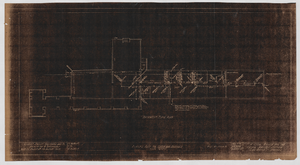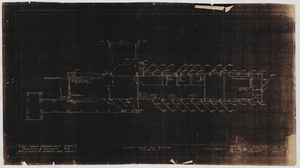Search the Special Collections and Archives Portal
Search Results

Details of Union Pacific Railroad clubhouse in Caliente, Nevada: architectural drawing
Date
Archival Collection
Description
From Union Pacific Railroad Collection (MS-00397). The scales are noted in the drawing. The bottom of the drawing says, "Gilbert Stanley Underwood & Co. Architects and Engineers. 730 S. Los Angeles St. Los Angeles Cal. Details. File No. 15684-L. Sheet No. 12 . Job No. 399. Date 8-10-27. A Club House For The Union Pacific System Caliente Nevada."
Image

Details of Union Pacific Railroad clubhouse in Caliente, Nevada: architectural drawing
Date
Archival Collection
Description
From Union Pacific Railroad Collection (MS-00397). The scales are noted in the drawing. The bottom of the drawing says, "Gilbert Stanley Underwood & Co. Architects and Engineers. 730 S. Los Angeles St. Los Angeles Cal. Details. File No. 15684-M. Sheet No. 13 . Job No. 399. Date 8-9-27. A Club House For The Union Pacific System Caliente Nevada."
Image

Details of Union Pacific Railroad clubhouse in Caliente, Nevada: architectural drawing
Date
Archival Collection
Description
From Union Pacific Railroad Collection (MS-00397). The scales are noted in the drawing. The bottom of the drawing says, "Gilbert Stanley Underwood & Co. Architects and Engineers. 730 S. Los Angeles St. Los Angeles Cal. Details. File No. 15684-N. Sheet No. 14 . Job No. 399. Date 8-10-27. A Club House For The Union Pacific System Caliente Nevada."
Image

Piping plan for Union Pacific Railroad clubhouse in Caliente, Nevada: architectural drawing
Date
Archival Collection
Description
From Union Pacific Railroad Collection (MS-00397). The scales are noted in the drawing. The drawing states, "Gilbert Stanley Underwood And Co. Architects & Engineers 730 So. Los Angeles St. Los Angeles Calif. Piping Plan For Water And Drainage. File No. 15684-P. Sheet #16. Job. #399. Date 8-10-27. A Club House For Union Pacific System Caliente Nevada."
Image

Piping plans for Union Pacific Railroad clubhouse in Caliente, Nevada: architectural drawing
Date
Archival Collection
Description
From Union Pacific Railroad Collection (MS-00397). The scales are noted in the drawing. The drawing states, "Gilbert Stanley Underwood And Co. Architects & Engineers. 730 So. Los Angeles St. Los Angeles Calif. Piping Plan For Hot And Cold Water. File No. 15684-Q. Sheet no. 17. Job no. 399. Date 8-10-27. A Club House For Union Pacific System Caliente Nevada."
Image

Piping and drainage plan for Union Pacific Railroad clubhouse in Caliente, Nevada: architectural drawing
Date
Archival Collection
Description
From Union Pacific Railroad Collection (MS-00397). The scales are noted in the drawing. Near the bottom it says, "Gilbert Stanley Underwood And Co. Architects & Engineers. 730 So. Los Angeles St. Los Angeles Calif. Piping And Drainage Plan. File No. 15684-R. Sheet #18. Job #399. Date 8-10-27. A Club House For Union Pacific System Caliente Nevada."
Image

Hot water piping plan for Union Pacific Railroad clubhouse in Caliente, Nevada: architectural drawing
Date
Archival Collection
Description
From Union Pacific Railroad Collection (MS-00397). The scales are noted in the drawing. The drawing states, "Gilbert Stanley Underwood And Co. Architects & Engineers. 730 So. Los Angeles St. Los Angeles Calif. Piping Plan For Hot Water. File No. 15684-S. Sheet No.19. Job No. 399. Date 8.10.27. A Club House For Union Pacific System Caliente Nevada."
Image

Piping plans for heating of Union Pacific Railroad clubhouse in Caliente, Nevada: architectural drawing
Date
Archival Collection
Description
From Union Pacific Railroad Collection (MS-00397). Near the bottom it says, "Gilbert Stanley Underwood And Co. Architects & Engineers. 730 So. Los Angeles St. Los Angeles Calif. Piping Plans For Heating. Scale 1/8" = 1' 0". File No. 15684-T. Sheet No. 20. Job No. 399. Date 8.10.27. A Club House For Union Pacific System Caliente Nevada."
Image

Details for Union Pacific Railroad club house in Caliente, Nevada: architectural drawing
Date
Archival Collection
Description
From Union Pacific Railroad Collection (MS-00397). The scales are noted in the drawing. Near the bottom it says, "Gilbert Stanley Underwood And Co. Architects & Engineers. Miscellaneous Details. A Club House For The Union Pacific System, Caliente, Nevada."
Image

Piping flans for heating a Union Pacific Railroad clubhouse in Caliente, Nevada: architectural drawing
Date
Archival Collection
Description
From Union Pacific Railroad Collection (MS-00397). Near the bottom it says, "Gilbert Stanley Underwood And Co. Architects & Engineers. 730 So. Los Angeles St. Los Angeles Calif. Dr. By Albert. Tr By. Ch. By Albert. Piping Plans For Heating. Scale 1/8" = 1'-0" . File No. 15684-T. Sheet No. 20. Job No. 399. Date 8-10-27. A Club House For The Union Pacific System, Caliente, Nevada."
Image
